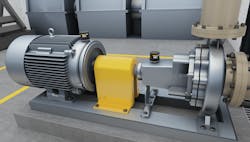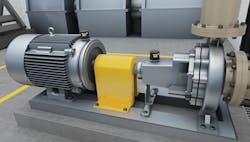The beginning of a flourishing condition-based maintenance program
In the last year, many of us discovered how helpful today’s technology and connectivity could be in taking our maintenance practices into the future, and how the ability to monitor machine health outside the plant has obvious advantages, including worker safety and workplace flexibility.
A Plant Services survey that Fluke conducted in the spring of 2020 suggested this heightened awareness took place early in the pandemic. One of the survey’s three key takeaways was that “investments will be made as soon as feasible in technologies that automate data collection and enable remote asset management.” (The other takeaways: an increased focus on sanitization and PPE inventory, and reaffirming the value of CMMS software.)
But countless maintenance and reliability teams we’ve encountered say that moving forward with condition-based maintenance in the past year has been complicated—by the lack of time and resources, insufficient management buy-in, depleted budgets, or all of the above.
I don’t have a one-size-fits-all solution to counter all of these challenges. But I do believe that companies working to infuse advanced technologies into their maintenance and reliability programs—especially those that begin small and grow—are moving closer to achieving workforce efficiencies, cost savings, ROI, and extended peak machine performance and health.
If you feel hard-pressed to know how to get started, here is an idea worth considering: Start small with wireless vibration sensors. Generate some results you can learn from, some ROI to share with management, and a bit of momentum to expand.
Are your competitors already planning to utilize them?
If you’re already considering this, good for you. You’re not alone, according to market statistics. The advantages of today’s wireless sensors—accuracy, reliability, easy setup, limited sensor maintenance, and more—have resulted in steady growth in industrial adoption over the last five years, the pandemic notwithstanding.
But Mordor Intelligence, a technology research and advisory firm, projects a near quadrupling of the market between 2021 to 2026. Valued at USD $4,631.8 million in 2020, the wireless sensors market is expected to reach $17,215.17 million in 2026, a compound annual growth rate of 24.2%, according to the Mordor report. Other research firms project similar growth patterns.
Wireless sensors are measurement tools for monitoring and recording your assets and environment’s physical conditions, such as power, temperature, chemicals and gas, and more. An increasingly popular subset is sensors focused on monitoring vibration (many of these also measure machine temperature).
Implementing wireless vibration sensors for at least a portion of your assets is an economical and low-risk way to jumpstart a condition-based maintenance program. You can eventually expand it and wean further away from reactive maintenance over time. The sensors in 2021 have overcome some of their prior drawbacks. They’re now more lightweight, have much longer battery life, and do not require vast amounts of bandwidth.
Modalities impacting the P-F curve
PdM tools do not equal automatic expertise
The P-F curve and the path to capacity assurance
Some newer model screening sensors are battery-less and generate power from either a TEG (Thermoelectric Generator) harvester or PV (photovoltaic energy) harvester. That means technicians don’t have to worry about upkeep. They’ve also come down in price.
New-generation sensors can provide screening or analysis vibration data—or both—to enable companies to monitor asset health without technicians spending enormous amounts of time inspecting the machines. The data they produce provides quick snapshots of asset condition that can easily be augmented over time with electrical, thermography, and other tools and devices for a deeper dive.
5 reasons to start your pilot program
Yes, wireless vibration sensors have been around for a few decades now. Here are five reasons to check them out today, if you haven’t already:
- Vibration data is a strong indicator of asset condition: While all machinery vibrates, monitoring excess vibration in rotating equipment is a smart way to identify issues early. It is an especially powerful tool for high-speed machines and is prominent among modalities on the P-F (Potential Failure) curve. Because machine vibration occurs in all directions, today’s sensors are designed to track three axes of vibration (longitudinal, transverse, and torsional), as well as asset temperature. The result is a more complete data set for evaluation, which over time can be augmented with data from other measurement modes on the P-F curve—oil analysis, thermography, ultrasound, or electric motor testing.
- Piezoelectric technology and other advancements are built-in: Piezoelectric sensors are well-known to provide high-resolution, high-frequency vibration readings. These readings are more in-depth than the devices from strictly microelectromechanical system (or MEMS) sensors that are still common today. Higher-quality sensors will feature a combination of piezoelectricity and MEMS and provide frequency readings of up to 10,000 Hz or more.
- Today’s sensors are supercharged by powerful software: Software analytics enable maintenance teams to constantly monitor and analyze vibration readings from production-critical assets. The software application generates customizable frequency band alarms, pre-programmed thresholds, trend visualization, and notifications. They offer an accessible way to view and recognize trends, outliers, and patterns in data. This allows users to analyze which fault is causing a problem to a machine. With this info, you can determine critical next-step actions, such as checking the shaft alignment or ordering a new part. In the end, you’re encouraging more extended peak operating performance and more effective use of maintenance team resources.
- Engineers can use predefined data parameters or set their own: Sensor setup is often a bone of contention. But with many of today’s wireless sensors, data thresholds are predefined to the asset type, and using these parameters is a smart, viable option. However, engineers can still set their own thresholds, if necessary. Setup takes just minutes per sensor. Data, trend charts, and insights are generated immediately, based on ISO standards, for screening or analyzing potential machine risks and faults.
- A broad array of assets can be monitored: New wireless sensors are equipped to work with most companies’ existing network configuration—Wi-Fi or Ethernet—and are designed for critical and also semi-critical and non-critical assets. That means, in time, companies can monitor data from large-scale deployments and be notified immediately when data thresholds are crossed. This enables maintenance technicians to ignore the 80% of machines operating normally and focus their time and money on those needing attention.
It’s the software that differentiates
By leveraging wireless sensors to jumpstart your condition-based maintenance program, you avoid having to work with disparate tools and less-than-compatible systems. Most sensors can be purchased in packs of a dozen or more, enabling you to experiment with a portion of assets and expand your program over time.
The market does include cheap, low-end sensors that spit out numbers but lack the quality software to make sense of those numbers. Invest instead in wireless sensors that combine hardware and software to provide you clear answers to questions such as, “Is that level of vibration good or bad?” and “Do I need to write a work order to fix my machine?” I call the software in sensors the “oxygen” that makes them usable and sustainable. It’s the differentiator.
Another point: While the focus here is on wireless sensors, I do not want to suggest that wired sensors are in any way passe. They aren’t. Parts of many plants lack Wi-Fi coverage, so wired sensors fill an essential void. Moreover, they are well-suited for your production-critical, high-end machines that mandate high volumes of high-resolution data to maintain.
Wired sensors can integrate successfully with wireless sensors in a large-scale condition-based maintenance program. But to jumpstart and initially expand your CBM program, I highly recommend wireless sensors—for their ease of implementation, ability to maintain, and quality of screening and analysis vibration data.
Don’t try going it alone
In my experience, CBM initiatives fail for a couple of reasons: (1) companies launch programs that are too big and complicated and lack the flexibility to course-correct early in the process, and (2) they try to go it alone.
I’ve already spent time discussing the first reason. Let me address the second. Find yourself a partner that has the expertise to help you. It’s not that your company isn’t smart enough to handle this on our own. It’s that you already have enough to do to keep the plant running. The pandemic has likely only added to your workload.
You don’t need to outsource everything and pay hundreds of thousands of dollars. Leveraging some outside training and guidance from an expert can be done on a smaller scale. But it could bring valuable, unbiased advice and reassure you that reliability is best as a shared journey, not a solo one.
I’ve worked with hundreds of customers on similar projects. Many have told me they don’t need any outside training or help. But I can count on one hand those that have successfully launched a condition-based maintenance program entirely on their own. Getting a partner can help companies get started and grow and still focus most of their time and resources on day-to-day demands.
This story originally appeared in the May 2021 issue of Plant Services. Subscribe to Plant Services here.
As a mechanical application and product specialist with Fluke Reliability, John Bernet, CMRP, works with customers from all industries to successfully implement their reliability programs. He has more than 30 years of experience in the maintenance and operation of commercial machinery and as a nuclear power plant electrician in the U.S. Navy, and holds a Category II Vibration Analyst certification.

